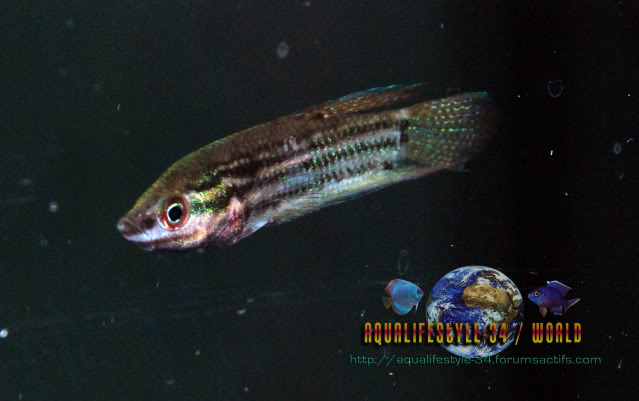| | | Trichopsis vittata: |  |
| | | Author | Message |
|---|
super novice

Number of posts : 142
Location : *******
Registration date : 2008-11-18
 |  Subject: Trichopsis vittata: Subject: Trichopsis vittata:  Mon Oct 26, 2009 12:00 am Mon Oct 26, 2009 12:00 am | |
| Trichopsis vittata. Classify: Actynopterggii.Subclass: Neopterygii Order: PerciformeUnder order: AnabantoïdeFamily: Ospronemidés, Bélontidés Subfamily: MacropodinaeKind: TrichopsisSpecies: vittataDescriptor : Vat and Valencian 1831. Etymology: Synonym (S) or common noun (S) : trichopsis vittatus (sci), Croaking gourami (ang), Knurrender Zwerggurami (all), gouramis grognor (French). Cupang (indo), Karim (badly), That bai tràv (Vietnamese soldier), Pa maht (Laos), Pla ka Pa (Thai)Origin : Asia. Thailand. Vietnam. Islands of Sumatra. Borneo. Malaysia. Java.Zone of life : surface & intermediate He lives in stagnant water or rivers with the currents very slow, the backwaters, the ponds, rice plantations and canals irrigation near the imposing vegetable cover.Maximum size : mâle= 7 cm - femelle= 7 cm. Weight : Life expectancy: 5 years.Temperature: 24°c to 28°c PH: 6,5 to 7,5. Hardness : 4° to 14° dGh. Conductivity: 
Description: The oblong body. The male grogne at the time of the parade. There are the varieties: “Kaeng Krachan Prejudice “,” Trenggam Kuantan”, “Double Blue Spot”,” and T. Harrisi. The dress with dominant brown is raised green reflections. Three or four horizontal bands whose two higher meets cross the body on the level of the caudal stalk. The odd fins are very strongly developed. Rays, of red colour orange with reflections metal blue, whose epithelium is richly strewn with point’s luminous blue-green, prolong them. The mouth small and is slightly raised. The line of the nose is often curved. T. vittata is able to produce a growl close to the croaking while making play its powerful pectoral musculature. This sound is amplified by the resonance of the body and is audible in the neighbourhoods of the aquarium.
Anatomy:
Behaviour: It is a fish which lives in bench (many 5 min… is recommended), for an aquarium of 200 litter. The males are territorial between them.
Never associate several males in roomy vats. It is a sharp, but peaceful fish that can cohabit in a Community aquarium with fish of small sizes, requiring the same characteristics.
Adoption of attitudes of intimidation - fins deployed to the maximum and growls are scenes of the everyday life. They lead sometimes to combat of mouth between males that, in general, do not have any annoying continuation.
Its name of grog nor comes from the sounds which it emits with his pectoral musculature at the time of various parades. This croaking, amplified by water, is perfectly audible to the maximum.
Nutrition : Omnivore. The dry food is accepted. A distribution of frozen food makes it possible to vary the menu. The alive preys - artémias, worms of vase and drosophilas - are particularly appreciated.
Food of the larvae: The alleviants are nourished as of the freestyle of microorganisms present among the floating plants. One offers then microphone-towards and of the anguillules vinegar that are quickly supplemented by nauplies of artémias.
Dimorphism: The males have a colouring sharper than that of the females, their fins are prolonged and their caudal is triangular.
Reproduction : Manufacturer of nest of bubble. As much of family members, the reproduction starts with construction by the male of a nest of bubbles.
More raised temperature and a water change are factors déclanchants with a neutral pH 7,0 and one hardness of 8°d gh to support the reproduction.
The parade is summarized with a stroke in circle accompanied by growls. Certain females lay to six hundred eggs. They share the parental guard with the male.
Bond of the Forum on the reproduction of fish:
Difficulty:
The Council for the aquariophilie: An aquarium with a good dense plantation is very appreciated with an interior filtration with a flow of 3/4 of the volume of the vat per hour. The rejection of the pump is directed towards an angle of the aquarium to avoid the movements. Des. Weekly water changes must be carried out (a quarter of the volume of the vat).
Volume minimal of the aquarium : 100 l.
Population density:
The Council for the angler:
Various:
Information: The cards of the fish may be by supplementing an experiment of the subject, or a comment misses concerning information on this card.
(Edict tyty)
Last edited by super novice on Mon Oct 26, 2009 5:00 pm; edited 1 time in total | |
|   | | super novice

Number of posts : 142
Location : *******
Registration date : 2008-11-18
 |  Subject: Re: Trichopsis vittata: Subject: Re: Trichopsis vittata:  Mon Oct 26, 2009 4:05 pm Mon Oct 26, 2009 4:05 pm | |
| Trichopsis vittata. Classe : Actynopterggii. Sous-classe : Neopterygii Ordre : PerciformeSous ordre : AnabantoïdeFamille : Ospronemidés, Bélontidés Sous-famille : MacropodinaeGenre: Trichopsis
Espèce: vittata Descripteur : Cuvier et Valencienne 1831. Etymologie:
Synonyme(s)ou nom commun(s): trichopsis vittatus (sci), Croaking gourami (ang), Knurrender Zwerggurami (all), gouramis grogneur (français). -Cupang (indo), Karim (mal) ,Cà bai tràv (viet), Pa maht (laos), Pla ka pa (thai)
Origine : Asie. Thaillande . Vietnam. Iles de Sumatra . Bornéo. Malaisie . Java .
Zone de vie : surface & intermédiaire Il vit dans les eaux stagnantes ou dans des riviéres aux courants très lent, les marigots, les mares, rizières et canaux d'irrigation à proximité de l'imposante couverture végétale. Taille maximale : mâle= 7 cm - femelle= 7 cm.
Poids : uniquement pour les gros poissonsEspérance de vie : 5 ans
Température : 24°c à 28°c pH : 6,5 à 7,5. Dureté : 4° à 14° dGh. Conductivité : 
Description : Le corps oblong. Le mâle grogne lors de la parade . Il y a les variétés : « Kaeng Krachan Dam « , »Trenggam Kuantan », « Double Spot Bleu » , »T .Harrisi. la robe est à dominante brune rehaussée de reflets verts. Le corps est traversé par trois ou quatre bandes horizontales dont les deux supérieures se rejoignent au niveau du pédoncule caudal. Les nageoires impaires sont très fortement développées. Elles se prolongent par des rayons, de couleur rouge orangé avec des reflets bleu métallique, dont l'épithélium est richement parsemé de points bleu-vert lumineux. La bouche est petite et légèrement relevée. La ligne du nez est souvent incurvée. T. vittata est capable de produire un grognement proche du coassement en faisant jouer sa puissante musculature pectorale. Ce son est amplifié par la résonance du corps et est audible aux alentours de l'aquarium.
Anatomie :Comportement : C’est un poisson qui vit en banc ( nombre de 5 min… est préconisé), pour un aquarium de 200 litres. Les mâles se montrent territoriaux entre eux. Ne jamais associez plusieurs mâles dans des bacs spacieux .C’est un poisson vif ,mais paisible qui peut cohabiter dans un aquarium communautaire avec des poissons de petites tailles,demandant les mêmes caractéristiques. L'adoption d'attitudes d'intimidation - nageoires déployées au maximum et grognements sont des scènes de la vie courante. Elles débouchent parfois sur des combats de bouche entre mâles qui, en général, n'ont aucune suite fâcheuse. Son nom de grogneur provient des sons qu’il émet avec sa musculature pectorale lors de différentes parades. Ce coassement, amplifié par l’eau, est parfaitement audible au maximum .
Nutrition : Omnivore. Les aliments secs sont acceptés. Une distribution de nourriture congelée permet de varier le menu. Les proies vivantes - artémias, vers de vase et drosophiles - sont particulièrement appréciées.
Nourriture des larves : Les alevins se nourrissent dès la nage libre de micro-organismes présents parmi les plantes flottantes. On offre ensuite des micro-vers et des anguillules du vinaigre qui sont rapidement complétés par des nauplies d'artémias.
Dimorphisme : Les mâles ont une coloration plus vive que celle des femelles, leurs nageoires sont plus prolongées et leur caudale est triangulaire.
Reproduction : Constructeur de nid de bulle. Comme beaucoup de membres de la famille ,la reproduction commence par la construction par le mâle d’un nid de bulles .Une température plus élevée et un changement d’eau sont des facteurs déclanchants avec un pH neutre 7,0 et une dureté de 8°d gh pour favoriser la reproduction.La parade se résume à une nage en cercle accompagnée de grognements. Certaines femelles pondent jusqu'à six cents œufs. Elles partagent la garde parentale avec le mâle.
Lien du Forum sur la reproduction du poisson :
Difficulté :
Conseil pour l'aquariophilie : Un aquarium avec une bonne plantation dense est très appréciée avec une filtration intérieure avec un débit de 3/4 du volume du bac par heure. Le rejet de la pompe est dirigé vers un angle de l'aquarium pour éviter les remous. des. Changements d'eau hebdomadaire doivent être réalisé (un quart du volume du bac).
Volume minimale de l'aquarium : 100 litres.
Densité de population :
Conseil pour le pêcheur :
Divers :Information : Les fiches des poissons peuvent être compléter par une expérience du sujet , ou d'un commentaire concernant un manque d'information sur cette fiche.
(Edit tyty) | |
|   | | | | Trichopsis vittata: |  |
|
Similar topics |  |
|
| | Permissions in this forum: | You cannot reply to topics in this forum
| |
| |
| |
TRANSLATOR FOR AQUARISTS OF WORLD
_________________
Select your language to translate the forum |
|
| Who is online? | In total there are 12 users online :: 0 Registered, 0 Hidden and 12 Guests None Most users ever online was 57 on Thu Feb 01, 2024 3:36 am |
|
